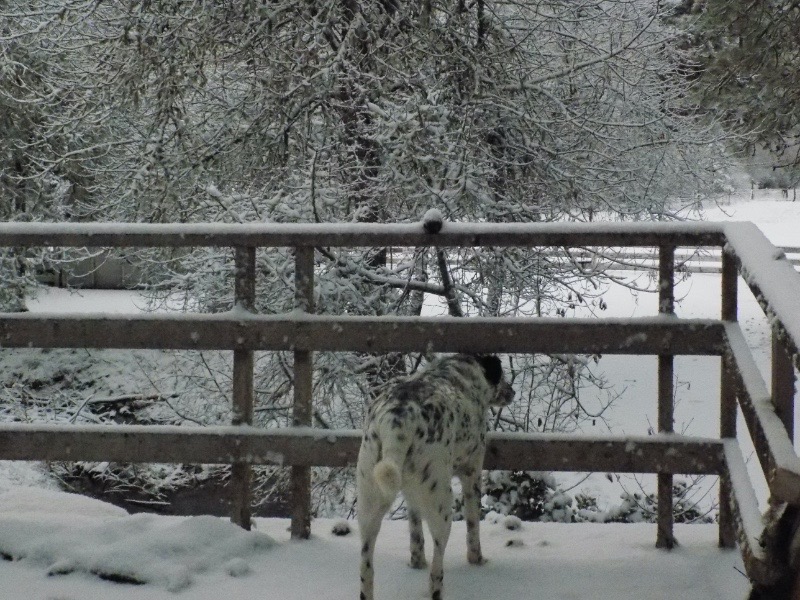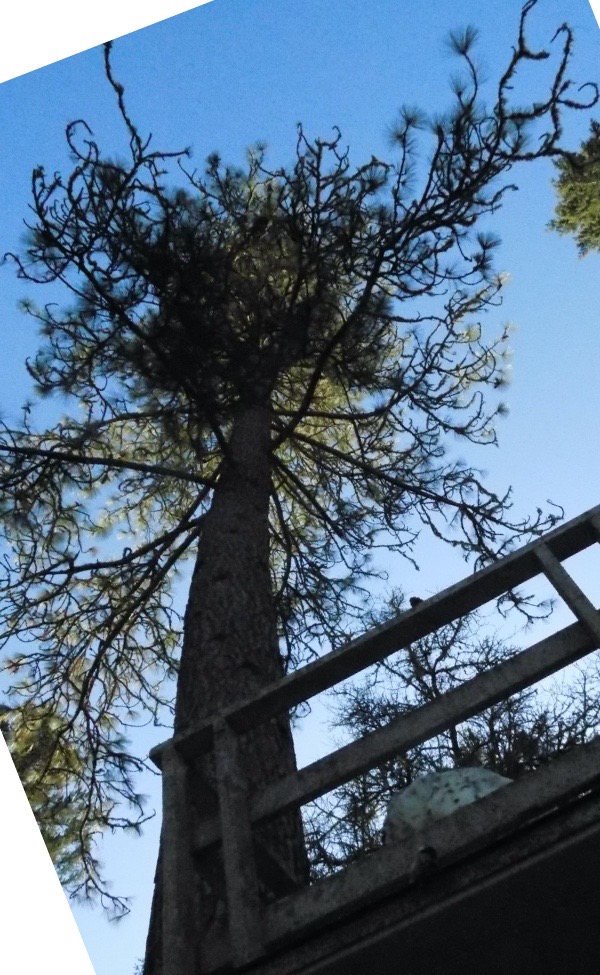Most great scientific discoveries are not accompanied with the triumphant shout “Eureka!” The more common reaction to a big discovery is, “Gee, that’s odd…” Oftentimes, good science is simply a matter of noticing something and realizing that it’s out of place. I present here a trivial but illustrative case. Last winter I let my dog Molly out onto the deck to get some fresh air, and I noticed something odd in the scene:

You probably don’t notice it; I didn’t notice it at first, either. It’s the dark object on the rail above her head. Here’s a closeup of that object:
![PineCone2]](../../_Media/pinecone2_med_hr.jpeg)
It’s a pine cone. You’re probably wondering why a pine cone sitting on a rail is odd. Here’s the view looking up from below the deck:

The deck is directly below a big pine tree that towers over the house. The pine cone fell from the tree and landed on the rail; you can even see it on the rail.
So what? you ask. Take a minute to think about the situation: the pine cone fell at least thirty feet, hit the rail—and didn’t bounce. It hit the rail and just stopped. Doesn’t that strike you as odd? When something falls from a height, it always bounces, unless it’s something squishy like a suicidal human body. So why didn’t the pine cone bounce?
The answer lies in the second photo: when it struck the rail, there was already a thick coat of wet snow on the rail, and the snow absorbed the energy of the impact. It would be rather like dropping a hunk of concrete onto a lazy suicidal human. They wouldn’t have to climb the building; the sidewalk would come to them and produce the same result. The squishy human body would absorb the energy of impact and the concrete wouldn’t bounce.
If you think in terms of processes, this would all have been obvious to you. If you think in terms of objects, then you would never have noticed it.
Addendum January 3rd, 2022
The other day a friend of mine sent me an email notifying me that somebody, somewhere on the Internet had rejected my explanation of how the pine cone ended up on the rail. Now, I’m getting this information second-hand, so it may be wrong, but apparently the critic’s plaint was that there is no snow underneath the pine cone, and the amount of snow on top of the pine cone is the same as the amount on the rail. This person therefore hypothesized that the pine cone must have fallen to the floor of the deck and bounced back up onto the rail before the snow fell. This, the critic claimed, was a more plausible explanation.
I can provide additional information that negates the critic’s hypothesis. I have been on that deck a number of times when pine cones from above had struck the deck. In no case has a pine cone bounced even 30 cm up, much less the full meter that would be required in this case. Pine cones just aren’t that elastic. Indeed, their unique structure tends towards highly inelastic collisions; I have seen pine cones hit the ground and bounce just a few centimeters. The inelasticity is not 100%; I have never seen a pine cone hit the ground and not bounce at all.
Can I reconcile the absence of snow underneath the pine cone with my hypothesis? I think so. Snow rarely falls in one fell swoop; normally it comes in batches. Between snowfalls, the snow tends to melt and diminish in depth. For all I know, the pine cone fells days before the photo, with its energy consumed by a previous snow accumulation.
Thus, the high inelasticity of the pine cone added to the inelasticity of the wet snow led to a perfectly inelastic collision, preventing a bounce.
Additional Addendum January 8th, 2022
I decided to empirically test my assumptions. I found a couple of pine cones and tossed them high in the air, letting them drop onto the hard surface of the driveway. I did this numerous times. The highest bounce was less than five inches, and some bounced less than an inch. Pine cones just don’t have a lot of elasticity.
